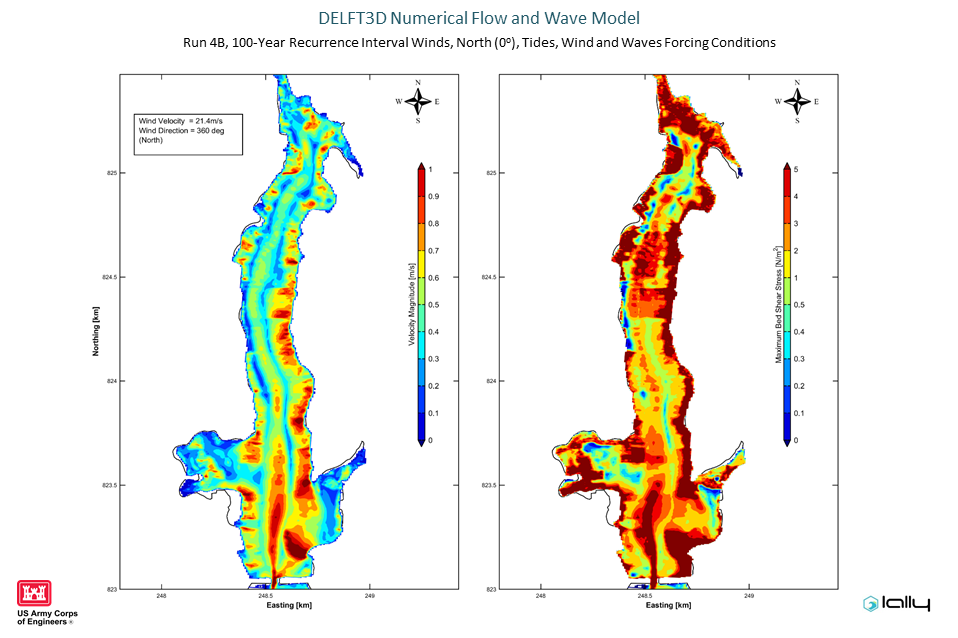DELFT3D Hydrodynamic Model
USEPA Estuary Superfund Site
The New Bedford Harbor Superfund Site extends from the Acushnet River estuary south through the ports of New Bedford and Fairhaven into Buzzards Bay. Historical industrial and urban development surrounding the Harbor has resulted in sediments contaminated with high concentrations of a number oil pollutants, foremost polychlorinated biphenyls (PCBs) and heavy metals.
Under Professional Services Contract Nos. W912WJ‐12‐ D‐0004 and W912WJ‐18‐C‐0003, Lally Consulting LLC (Lally LLC) was tasked by USACE-New England District to develop a hydrodynamic model as part of continued technical support provided to USACE and USEPA in optimizing the cleanup strategy for the New Bedford Harbor Superfund Site. With the support of Deltares, architect of the DELFT3D hydrodynamic modeling suite, Lally LLC developed a coupled, depth-averaged flow and numerical model of the entire New Bedford Harbor estuary and Buzzards Bay.
The main components employed were the coupled Delft3D-Flow and the Delft3D-Wave modules. Delft3D-Flow forms the core of the model system, simulating water motion due to tidal and meteorological forcing by solving the unsteady shallow-water equations that consist of the continuity equation, the horizontal momentum equations, the transport equation under the shallow water and Boussinesq assumptions. Wave effects are integrated in the flow simulation by running the 3rd generation SWAN wave processor. The results of the wave simulation, such as wave height, peak spectral period, and mass fluxes are stored on the computational flow grid and included in the flow calculations through additional driving terms near surface and bed, enhanced bed shear stress, mass flux and turbulence.

The model was calibrated and validated to simulate the site’s hydrodynamic and sediment transport regime under various storm recurrence interval, bathymetry, and water level conditions. A thorough modeling report was prepared and the model accepted for use following peer review by USACE-NAE and USACE Engineering Research Development Center (ERDC).
The New Bedford Harbor hydrodynamic model developed provides capability to estimate such effects as bed shear stresses to help inform the site’s cleanup strategy through evaluation of stability of cover and cap materials, recontamination potential of sequencing alternatives, and other remedial design and management considerations. Foremost thus far the hydrodynamic model has been used to assess stable bed particle sizes in support of erosion control layer design for multiple subtidal engineered caps.
Related Projects
Services Provided
Specify, Acquire and Process Model Boundary, Bathymetry, MetOcean, Currents and Wave data
DELFT3D Coupled Flow – Wave Model Setup, Calibration and Validation
Prepare Hydrodynamic Model Report for Peer-review
Perform 60+ Simulations for Multiple Recurrence Interval Scenarios and Remediation Areas
Project Management, Communications and Administration
Updated Wind and Wave Calculations using New Forcing Data and Boundary Conditions (bathymetry)
Developed Estimates of Bed Shear Stresses for various (30-yr, 100-yr) Recurrence Interval Conditions
Advance 100-yr Current Velocities, Patterns, and Bed Shear Stresses as Input for Cap Design
Location
New England, USA
Delft, The Netherlands
Period
2017 – 2020

For its work under USACE Contract W912WJ-18-C-0003, Lally Consulting LLC was nominated by the NBHSS Project Leadership and selected by an awards panel of EPA representatives from across the Agency as the 2020 national recipient of the USEPA Administrator’s Award for Outstanding Accomplishments by a Small Business Contractor.